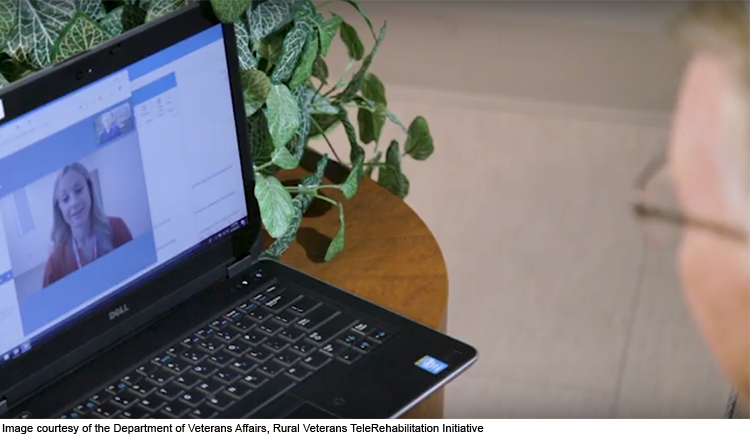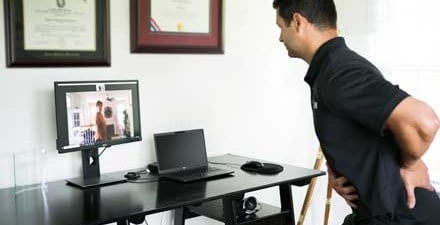
Have you ever wanted your physical therapist to teach you how to move better in your home? Is it hard to get to your appointments?
Telehealth — a live, one-on-one video appointment with your physical therapist — may be a solution. Telehealth is becoming a popular option that enables patients to see and talk to their health care providers. A growing number of physical therapists are offering telehealth services as a part of an overall treatment plan. This allows you to get the help you need in the comfort and convenience of your home or workplace.
Here are a few reasons to consider telehealth physical therapy.
1. Accessibility.
Telehealth can help you either get connected with a physical therapist or stay connected with your physical therapist. Telehealth also may make it possible for you to work with a physical therapist who has experience treating people with your condition or a specialist, who may not be near you.
2. Home safety.
If falling is a concern, a telehealth appointment with your physical therapist is an opportunity to identify specific ways to improve your home’s safety. They also can discuss what you should do if you fall.
3. Personalized care.
During a private telehealth visit, you will work one-on-one with your physical therapist without distractions. You also can involve family members or caregivers in your appointment, if you like.
4. Success rates.
Patients who take part in telehealth physical therapy are more likely to stick to their home exercise programs. Your physical therapist can provide you with a safe and effective exercise program to do at home based on your specific needs and goals. Sticking to your prescribed exercise program is a vital part of your long-term health.
5. Time savings.
There’s no waiting room. And after your telehealth appointment, you can quickly get back to what you were doing at home or work without having to spend time on the road.
6. Transportation and other needs.
No need to drive! A telehealth appointment reduces the burden of traveling to appointments. Telehealth also works well for:
- Parents with a child at home.
- Caregivers who are concerned about the physical demands of transporting their loved ones.
- Those who don’t have easy access to personal or public transportation.
The majority of patients who have used telehealth physical therapy were satisfied with their experience and would do it again. Patients expressed feeling connected and supported by their telehealth physical therapist. Having this support at home while going through a rehab program is valuable. Studies show that, for certain health conditions, telehealth physical therapy can result in equal or better outcomes.
What are the considerations for telehealth physical therapy?
Telehealth may or may not be available in your area. And not all insurance providers cover telehealth. Depending on your health condition, you may need to meet in person with your physical therapist for an initial evaluation and to determine if telehealth physical therapy or hybrid care — a combination of in-person and telehealth visits — is the right approach for you.
Who can participate in telehealth physical therapy?
You and your physical therapist should discuss whether telehealth is a good fit for you. Your physical therapist can help to identify and reduce any barriers that may affect your care.
People of all ages and who have a variety of symptoms and medical conditions may be candidates for telehealth. A few examples of conditions for which a physical therapist can help you virtually include:
- Balance.
- Postoperative care.
- Chronic pain management.
- Cancer rehabilitation.
- Other conditions your physical therapist determines are appropriate for telehealth.
Practice laws governing the use of telehealth services vary by state. Check with your health care insurance provider to see if telehealth services are covered under your plan.
What do I need to participate in a telehealth physical therapy visit?
There is no training required for patients to take part in telehealth. Typically, you will need internet service and access to a computer or other device that has a video camera and microphone. If your physical therapist offers telehealth services, they will provide more details and instructions.
Physical therapists are movement experts. They improve quality of life through hands-on care, patient education, and prescribed movement. In the U.S., you do not need a referral to see a physical therapist for an evaluation and, in most cases, treatment.* To find a physical therapist who offers telehealth services, use the American Physical Therapy Association's Find a PT tool and select the filter for “telehealth visits available” after entering your search criteria and location details.
Ask whether the physical therapist or clinic participates in your health care plan before making an appointment, or contact your health insurance company for help.
Find a PT Near You
*Insurance, corporate policies, or state laws may still require a physician’s referral or limit treatment scope and duration without one. Insurance policies also may limit you to in-network providers.
Additional Resources
- What Is Digital Health in Physical Therapy and Is It Right for Me?
- Answers to Frequently Asked Questions About Telehealth in Physical Therapy
- Podcast: Telehealth Physical Therapy — Why Now More Than Ever?
- Benefits of Physical Therapy
- Podcast: Using Telehealth to Help Patients With Advanced Cancer Improve Quality of Life


